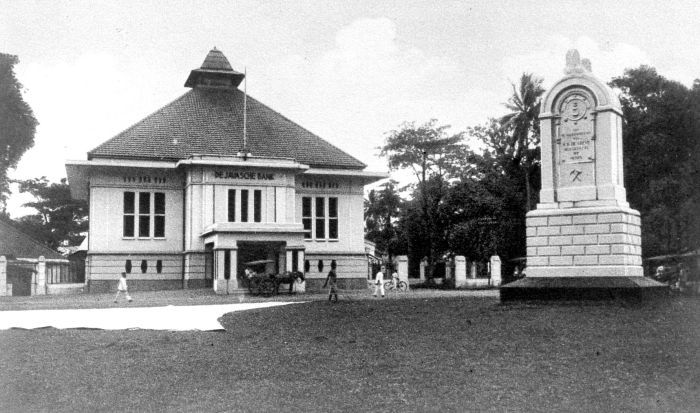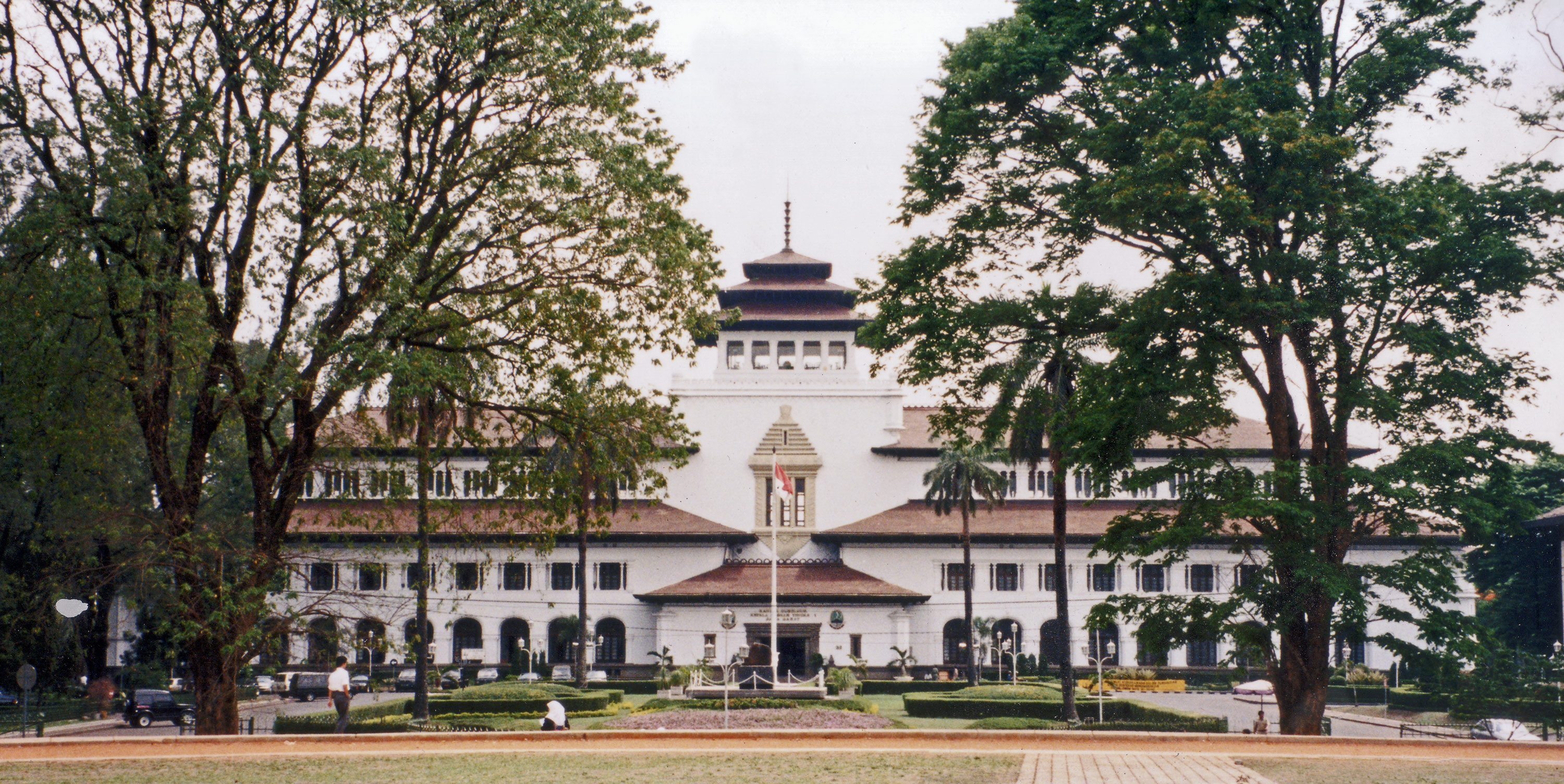|
Old Bank Indonesia Building, Padang
Bank Indonesia Museum of Padang ( id, Museum Bank Indonesia Padang) is a former bank building located in Padang, Indonesia. The building was built on March 31, 1921 as the Padang branch office of De Javasche Bank before it was taken over by Bank Indonesia on July 1, 1953. Completed in 1925, the building was initially used as the new building for De Javasche Bank, replacing the old de Javasche Bank building at Jalan Nipah, near Padang Beach. The location was formerly the center of the financial offices, commerce and military in colonial Padang. Old colonial buildings from the Dutch East Indies period can still be found lining the waterfront street of Batang Arau. History Padang is one of the great cities of Sumatra. Located on the west coast of Sumatra, Padang evolved into a commercial and military city between the 18th and 19th centuries. In 1864, De Javasche Bank officially opened a branch office in Padang. This was the third branch of de Javasche Bank in the Netherlands Indie ... [...More Info...] [...Related Items...] OR: [Wikipedia] [Google] [Baidu] |
New Indies Style
New Indies Style ( nl, Nieuwe Indische Bouwstijl) is a modern architectural style used in the Dutch East Indies (now Indonesia) between the late 19th century through pre-World War II 20th century. New Indies Style is basically early modern (western) architecture (e.g. Rationalism and Art Deco), which applies local architectural elements such as wide eaves or prominent roof as an attempt to conform with the tropical climate of Indonesia. Even though New Indies Style refers specifically to the Dutch Rationalism movement that appeared in 1910s Indonesia, for the purpose of covering the many architectural styles that appeared during the brief early modern period, the term is used as a general term for all the architectural styles that appear between the late 19th-century to pre-World War II 20th-century. History The attempt to synthesize Dutch architecture with local Indonesian architecture had already started since the 18th century. Heavy maintenance of the 17th-century Dutch-styl ... [...More Info...] [...Related Items...] OR: [Wikipedia] [Google] [Baidu] |
Padang
Padang () is the capital and largest city of the Indonesian province of West Sumatra. With a Census population of 1,015,000 as of 2022, it is the 16th most populous city in Indonesia and the most populous city on the west coast of Sumatra. The Padang metropolitan area is the third most populous metropolitan area in Sumatra with a population of over 1.4 million. Padang is widely known for its Minangkabau culture, cuisine, and sunset beaches. The city had historically been a trading center since the pre-colonial era, trading in pepper and gold. The Dutch made contact with the city in the mid 17th century, eventually constructing a fortress and taking over control of the city from the Pagaruyung Kingdom. Save for several interruptions of British rule, Padang remained part of the Dutch East Indies as one of its major cities until Indonesian independence. In 1906, Padang along with Palembang became the first populated places in Sumatra to achieve city status (''gemeente''). Hi ... [...More Info...] [...Related Items...] OR: [Wikipedia] [Google] [Baidu] |
Indonesia
Indonesia, officially the Republic of Indonesia, is a country in Southeast Asia and Oceania between the Indian and Pacific oceans. It consists of over 17,000 islands, including Sumatra, Java, Sulawesi, and parts of Borneo and New Guinea. Indonesia is the world's largest archipelagic state and the 14th-largest country by area, at . With over 275 million people, Indonesia is the world's fourth-most populous country and the most populous Muslim-majority country. Java, the world's most populous island, is home to more than half of the country's population. Indonesia is a presidential republic with an elected legislature. It has 38 provinces, of which nine have special status. The country's capital, Jakarta, is the world's second-most populous urban area. Indonesia shares land borders with Papua New Guinea, East Timor, and the eastern part of Malaysia, as well as maritime borders with Singapore, Vietnam, Thailand, the Philippines, Australia, Palau, and India ... [...More Info...] [...Related Items...] OR: [Wikipedia] [Google] [Baidu] |
Padang Barat
West Padang is a subdistrict ( kecamatan) in the city of Padang, West Sumatra, Indonesia Indonesia, officially the Republic of Indonesia, is a country in Southeast Asia and Oceania between the Indian and Pacific oceans. It consists of over 17,000 islands, including Sumatra, Java, Sulawesi, and parts of Borneo and New Guine .... In the administrative area of this district, West Sumatra, the governor's office and the hall town Padang is located. Padang {{WSumatra-geo-stub ... [...More Info...] [...Related Items...] OR: [Wikipedia] [Google] [Baidu] |
Bank Indonesia
Bank Indonesia (BI) is the central bank of the Republic of Indonesia. It replaced in 1953 the Bank of Java ( nl, De Javasche Bank, DJB), which had been created in 1828 to serve the financial needs of the Dutch East Indies. History Bank of Java King William I of the Netherlands granted the right to create a private bank in the Indies in 1826, which was named . It was founded on 24 January 1828 and later became the bank of issue of the Dutch East Indies. The bank regulated and issued the Netherlands Indies gulden. In 1881, an office of the Bank of Java was opened in Amsterdam. Later followed the opening of an office in New York. By 1930 the bank owned sixteen office branches in the Dutch East Indies: Bandung, Cirebon, Semarang, Yogyakarta, Surakarta, Surabaya, Malang, Kediri, Banda Aceh, Medan, Padang, Palembang, Banjarmasin, Pontianak, Makassar, and Manado. The Bank of Java was operated as a private bank and individuals as well as industries etc. could get help in the bank ... [...More Info...] [...Related Items...] OR: [Wikipedia] [Google] [Baidu] |
Semarang
Semarang ( jv, ꦏꦸꦛꦯꦼꦩꦫꦁ , Pegon: سماراڠ) is the capital and largest city of Central Java province in Indonesia. It was a major port during the Dutch colonial era, and is still an important regional center and port today. The city has been named as the cleanest tourist destination in Southeast Asia by the ASEAN Clean Tourist City Standard (ACTCS) for 2020–2022. It has an area of and is located at . The population of the city was 1,555,984 at the 2010 censusBiro Pusat Statistik, Jakarta, 2011. and 1,653,524 at the 2020 census,Badan Pusat Statistik, Jakarta, 2021. making it Indonesia's ninth most populous city after Jakarta, Surabaya, Bekasi, Bandung, Medan, Depok, Tangerang and Palembang. The built-up urban area had 3,183,516 inhabitants at the 2010 census spread over two cities and 26 districts. The Semarang metropolitan area (a.k.a. ''Kedungsepur'') has a population of over 6 million in 2020 (''see Greater Semarang section''). The population of the cit ... [...More Info...] [...Related Items...] OR: [Wikipedia] [Google] [Baidu] |
Surabaya
Surabaya ( jv, ꦱꦸꦫꦧꦪ or jv, ꦯꦹꦫꦨꦪ; ; ) is the capital city of the Provinces of Indonesia, Indonesian province of East Java and the List of Indonesian cities by population, second-largest city in Indonesia, after Jakarta. Located on the northeastern border of Java island, on the Madura Strait, it is one of the earliest port cities in Southeast Asia. According to the Government of Indonesia, National Development Planning Agency, Surabaya is one of the Regions of Indonesia#Development regions, four main central cities of Indonesia, alongside Jakarta, Medan, and Makassar. The city has a population of 2.87 million within its city limits at the 2020 census and 9.5 million in the extended Surabaya metropolitan area, making it the List of metropolitan areas in Indonesia, second-largest metropolitan area in Indonesia. The city was settled in the 10th century by the Janggala, Kingdom of Janggala, one of the two Javanese kingdoms that was formed in 1045 when ... [...More Info...] [...Related Items...] OR: [Wikipedia] [Google] [Baidu] |
Batavia, Dutch East Indies
Batavia was the capital of the Dutch East Indies. The area corresponds to present-day Jakarta, Indonesia. Batavia can refer to the city proper or its suburbs and hinterland, the Ommelanden, which included the much-larger area of the Residency of Batavia in the present-day Indonesian provinces of Jakarta, Banten and West Java. The founding of Batavia by the Dutch in 1619, on the site of the ruins of Jayakarta, led to the establishment of a Dutch colony; Batavia became the center of the Dutch East India Company's trading network in Asia. Monopolies on local produce were augmented by non-indigenous cash crops. To safeguard their commercial interests, the company and the colonial administration absorbed surrounding territory. Batavia is on the north coast of Java, in a sheltered bay, on a land of marshland and hills crisscrossed with canals. The city had two centers: Oud Batavia (the oldest part of the city) and the relatively-newer city, on higher ground to the south. It was ... [...More Info...] [...Related Items...] OR: [Wikipedia] [Google] [Baidu] |
Jakarta
Jakarta (; , bew, Jakarte), officially the Special Capital Region of Jakarta ( id, Daerah Khusus Ibukota Jakarta) is the capital and largest city of Indonesia. Lying on the northwest coast of Java, the world's most populous island, Jakarta is the largest city in Southeast Asia and serves as the diplomatic capital of ASEAN. The city is the economic, cultural, and political centre of Indonesia. It possesses a province-level status and has a population of 10,609,681 as of mid 2021.Badan Pusat Statistik, Jakarta, 2022. Although Jakarta extends over only , and thus has the smallest area of any Indonesian province, its metropolitan area covers , which includes the satellite cities Bogor, Depok, Tangerang, South Tangerang, and Bekasi, and has an estimated population of 35 million , making it the largest urban area in Indonesia and the second-largest in the world (after Tokyo). Jakarta ranks first among the Indonesian provinces in human development index. Jakarta's busin ... [...More Info...] [...Related Items...] OR: [Wikipedia] [Google] [Baidu] |
Muara Port
The Muara Port ( ms, Pelabuhan Muara), also known as Muara Harbour, is a seaport operated by the Muara Port Company (MPC) Sdn Bhd, under the supervision of the Maritime and Port Authority of Brunei Darussalam. The port also contributed to the Brunei Darussalam–Indonesia–Malaysia–Philippines East ASEAN Growth Area (BIMP-EAGA). Geography The port's strategic location allows access to the Oceania, Indian Ocean, Pacific Ocean and Atlantic Ocean. The port lies 28 km from the capital of Brunei, Bandar Seri Begawan and it was considered to be the Gateway for Trade. The Muara Naval Base lies north-east of the port, and Muara Besar Island in the west. The port also contains a free trade zone, which is known as the Muara Export Zone (MEZ). History In 1973, the port was officially completed and it became the largest port in Brunei. In 1982, the port underwent a B$26.5 million expansion project. It can also be noted after 1997, the port might not have been in use due to t ... [...More Info...] [...Related Items...] OR: [Wikipedia] [Google] [Baidu] |
Willem Hendrik De Greve
Willem Hendrik de Greve (15 April 184022 October 1872) was a Dutch geologist. He was known for his discovery of the coal mine in Sawahlunto, Dutch East Indies (now Indonesia). Biography Willem Hendrik de Greve was born in Franeker, Netherlands on April 15, 1840. He received training in mining engineering at the Delft University of Technology, Delft Royal Academy in 1855. After four years, at the age of 19, he earned his mining engineering degree from the academy. De Greve decided to seek employment in the Dutch East Indies, Indies. On December 14, 1861, he was appointed by the Dutch East Indies government to handle various studies of minerals, in accordance with the then Governor-General of the Dutch East Indies Ludolph Anne Jan Wilt Sloet van de Beele, van de Beele's decision. Not long afterward, on December 27, 1861, he married E.L.T. Baroness, daughter of the couple W.R. Baron Hoevelinggi and E.J.W. Shutter. From this marriage, he had three children. Career In August 1862, ... [...More Info...] [...Related Items...] OR: [Wikipedia] [Google] [Baidu] |




